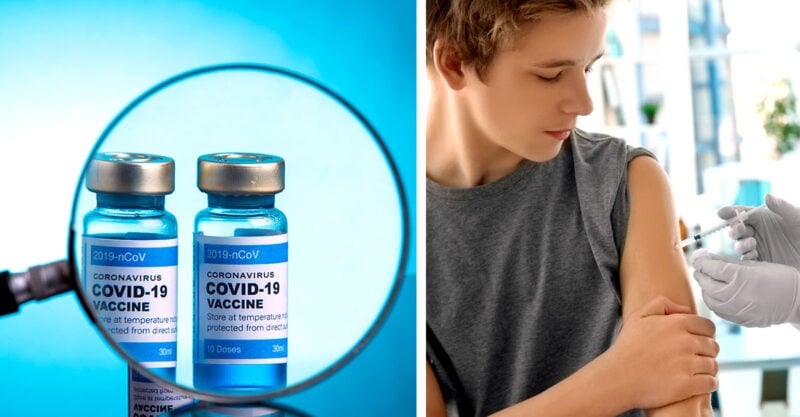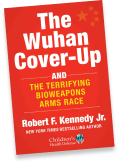Two COVID Shots Raise Risk of Anaphylaxis, Heart Issues in Older Adolescents
A Norwegian study found a low but significant risk of serious side effects among adolescents a short time following a second COVID-19 vaccination. The tenfold higher risk for anaphylaxis was the most concerning outcome, but the researchers also found swollen lymph nodes and heart issues.
Miss a day, miss a lot. Subscribe to The Defender's Top News of the Day. It's free.
Teens receiving two doses of an mRNA COVID-19 vaccine were at much higher risk for anaphylaxis, swollen glands and two types of serious heart inflammation, according to a study by the Norwegian Institute of Public Health (NIPH).
When the post-vaccination observation window increased from 14 to 42 days they observed a 39% higher risk for appendicitis after the first shot and a 43% increase after the second dose.
The study also confirmed that despite those safety signals, serious post-infection outcomes were rare among COVID-19-vaccinated adolescents ages 15-19.
Two doses led to tenfold increase in risk of anaphylaxis in teens
Researchers led by German Tapia, Ph.D., a postdoctoral epidemiologist at NIPH, enrolled 496,432 adolescents born between 2002 and 2009, living in Norway and unvaccinated before the official vaccine approval for this age group.
Exposure categories were: no vaccination, one dose of COVID-19 vaccine or two doses.
Teens experiencing side effects within 14 days of receiving the shot were examined for anaphylaxis, death, acute appendicitis, convulsions, facial nerve palsy, herpes zoster (shingles), swollen glands, pericarditis, myocarditis, irregular heartbeat, blood vessel disorders, joint disease and several other adverse reactions.
The researchers found no statistically significant associations between first-dose vaccination and any of the outcomes when comparing vaccinated and unvaccinated groups, but several serious safety signals arose after the second shot.
Second-dose vaccination was associated with a greater-than-tenfold increase in the risk of anaphylaxis compared with unvaccinated, a 133% greater risk of swollen glands and a 427% rise in myo- and pericarditis at up to 28 days after the last dose.
Anaphylaxis is a serious reaction, usually caused by allergy, with mild to life-threatening severity. Symptoms include coughing, wheezing, tightness in the chest, shortness of breath or trouble breathing, thick or “heavy” tongue and slurred speech.
Some of the study participants who experienced symptoms of anaphylaxis recalled a feeling of doom right before their episode. Unconsciousness and difficulty breathing are among the most serious signs.
In addition to allergies, anaphylaxis may be caused by injected penicillin-class drugs, muscle relaxants used during anesthesia and nonsteroidal anti-inflammatory drugs (for example aspirin, ibuprofen).
Swollen lymph nodes (glands), or lymphadenopathy, are typically caused by bacterial or viral infections. Symptoms include tenderness, pain or swelling in the neck, under the chin, in the armpits or groin.
Lymphadenopathy is quite common after many childhood and adult vaccinations, which is likely why the authors did not delve into its significance in their study.
Myocarditis and pericarditis are two extensively studied forms of heart inflammation occurring after mRNA COVID-19 vaccination.
Pericarditis involves inflammation of the pericardium, a fluid-filled sac surrounding heart muscle. Pericarditis symptoms resemble heart attack: pain behind the breastbone or on the left side of the chest, shortness of breath, swollen abdomen and fatigue or weakness.
Pericarditis usually resolves on its own but more serious cases may persist or progress to recurrent or chronic disease. Since Tapia et al.’s study observation window was only two weeks, no conclusions could be drawn on the seriousness of these cases. And aside from citing Israeli and Chinese studies mentioning pericarditis as a “most concerning” side effect, Tapia et al. did not provide any insights.
Myocarditis, or inflammation of heart muscle, is also mainly caused by infections and the symptoms are similar to pericarditis. Myocarditis complications are more serious, though, and include heart failure, irregular heartbeat leading to stroke and heart attack.
Again, Tapia et al.’s narrow observation window did not allow a thorough assessment of heart-related adverse events in this population. The Defender reported that myopericarditis heart damage persisted in 63% of teens for months post-vaccination.
While health officials often refer to post-COVID-19 vaccine myocarditis and pericarditis as “mild” or “transient” (or both), other observers have questioned whether any case of heart damage can be considered clinically insignificant.
Researchers used high-quality data, excluded teens vaccinated before early 2021
By enrolling a large number of subjects and applying different observational time periods, Tapia et al. not only captured all available data but purposely subjected their data to a high level of statistical scrutiny.
This allowed them to establish meaningful correlations between exposures and even rare outcomes.
The investigators also used high-quality data within a health system with mandatory reporting, which means they captured all available applicable data.
They noted in their discussion that because COVID-19 shots and healthcare are free in Norway their results were relatively free of “socioeconomic confounding” factors, such as income level or social status that might have skewed their conclusions toward a specific group of young Norwegians.
But as a group, the study team was anything but disinterested as 3 of 13 had financial or professional conflicts of interest. Two co-authors had participated in research projects funded by Novo Nordisk, LEO Pharma and Bristol-Myers Squibb.
However, Tapia et al. brushed aside these funding relationships by noting that “no personal fees” were involved and that those studies were unrelated to the current paper.
Indirect payments may reduce the appearance of conflicts of interest but they do not eliminate them or the potential influence of unreported direct payments, which can take many forms.
Another co-author had worked on projects and clinical trials funded by Novo Nordisk, GSK, AstraZeneca and Boehringer-Ingelheim, and had received a “lecture fee” from Sanofi-Aventis. Lecture fees are a common way for drug sponsors to sweeten the pot for researchers in return for a few hours of work.
Tapia et al.’s exclusion of adolescents vaccinated before early 2021 seems unusual but, according to the authors, they did this to eliminate adolescents vaccinated due to existing medical conditions or a perceived or anticipated vulnerability to coronavirus — for example, immunocompromised or those undergoing chemotherapy.
Since many similarly vulnerable children were likely included among their test subjects, this exclusion was probably unnecessary and served to reduce the safety signals researchers were looking for.
Finally, all subjects experiencing serious adverse events (excluding herpes zoster) were diagnosed in a hospital setting. Patients already sick enough to seek that level of care would tend to have worse outcomes and hence a higher prevalence of more serious side effects.
On the other hand, because vaccines were not mandated in Norway for this age group, Tapia et al. suggested that vaccine-seekers might be healthier to begin with, and therefore already predisposed to experiencing fewer adverse events. This is known as the “healthy vaccine effect.”
Sign up for free news and updates from Children’s Health Defense. CHD focuses on legal strategies to defend the health of our children and obtain justice for those injured. We can't do it without your support.





